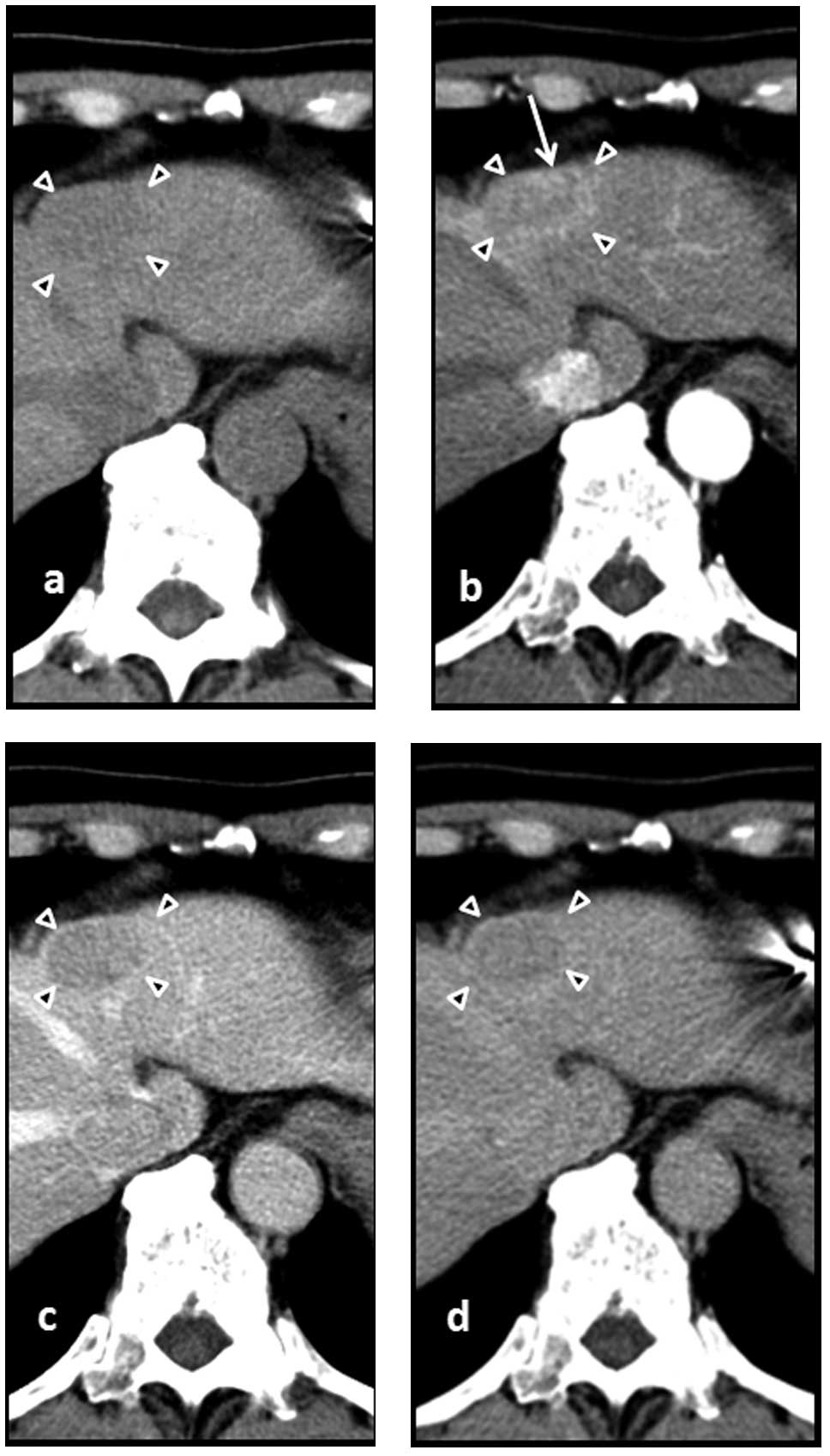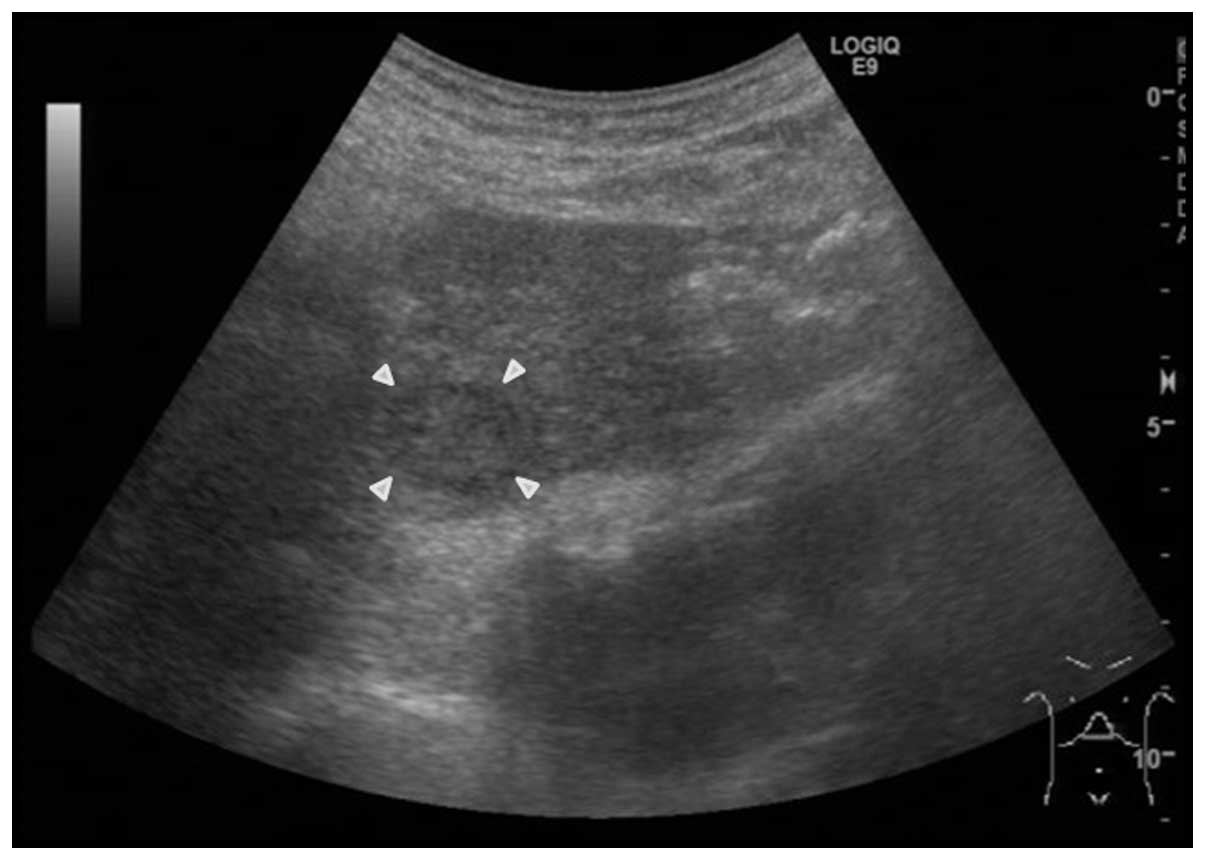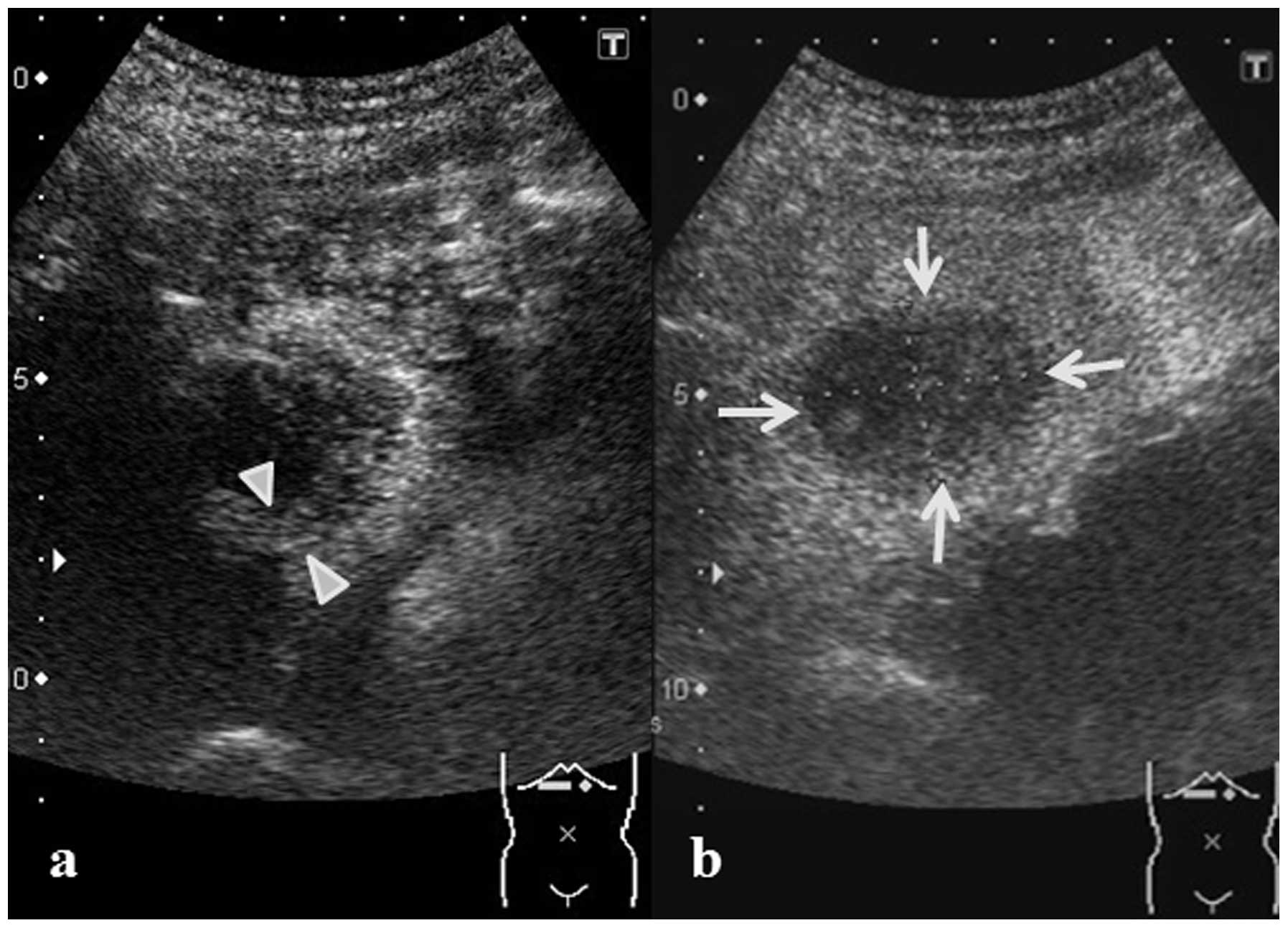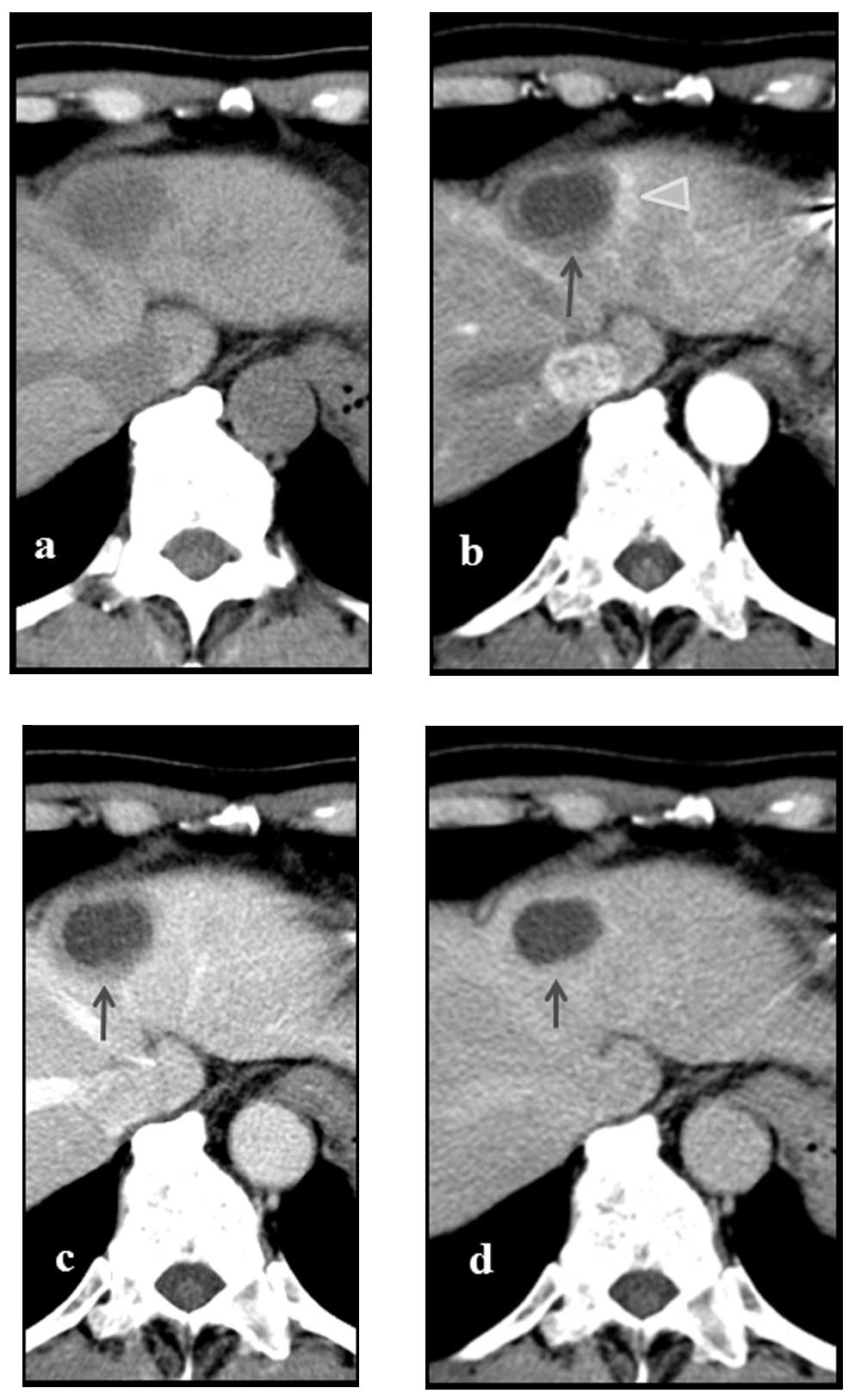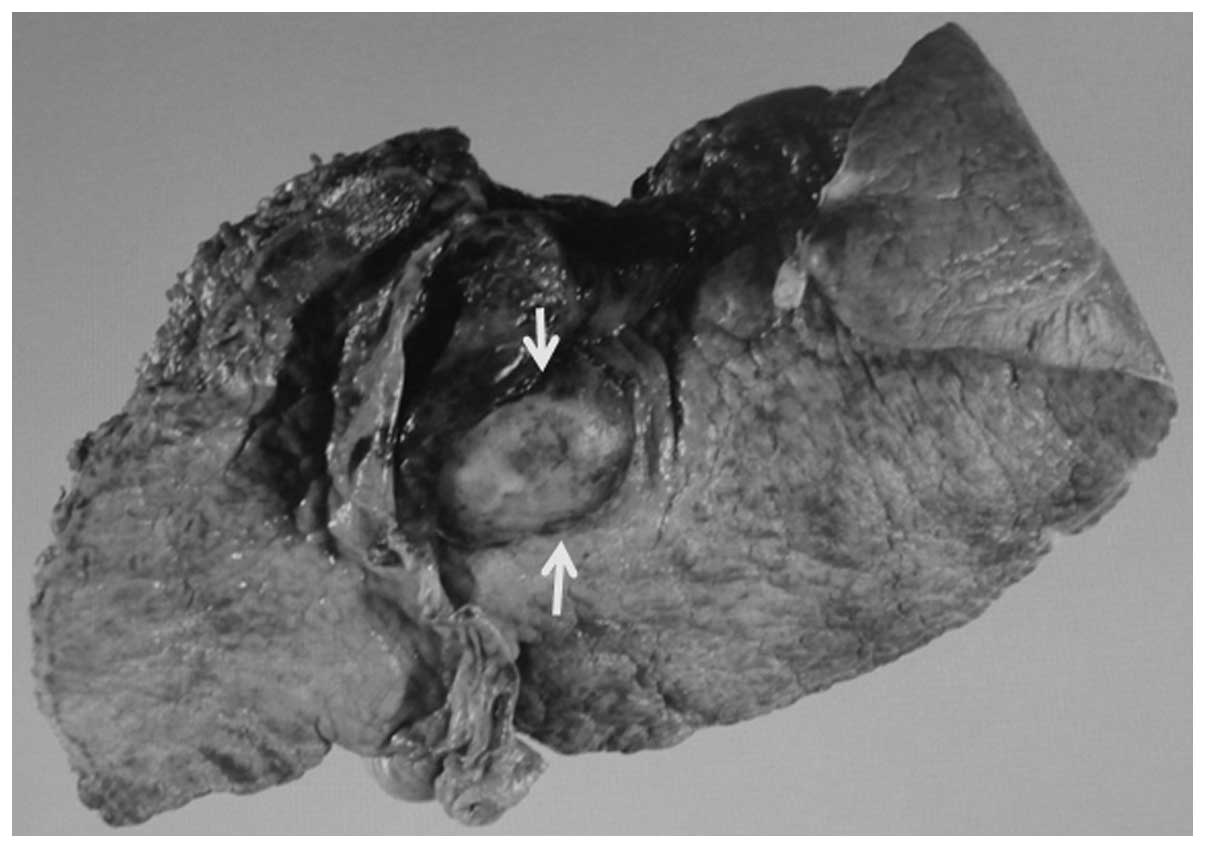Spontaneous complete necrosis of hepatocellular carcinoma: A case report and review of the literature
- Authors:
- Published online on: February 5, 2015 https://doi.org/10.3892/ol.2015.2937
- Pages: 1520-1526
-
Copyright: © Takeda et al. This is an open access article distributed under the terms of Creative Commons Attribution License.
Abstract
Introduction
Hepatocellular carcinomas (HCCs) are potentially life-threatening (1), whose prognosis is dependent on the tumor stage at the time of diagnosis and the possibility of providing radical treatment. Thanks to the development of clinically based staging systems such as the Barcelona Clinical Liver Cancer (BCLC) classification, which takes into account parameters as liver functionality (often as a consequence of underlying liver cirrhosis; Child-Pugh score), tumor burden (number and invasiveness), clinical performance and divides patients into very early/early, intermediate, advanced, and end-stage, the life expectancy of HCC patients can be reliably predicted and appropriate treatment may be identified (2). According to the classification system, some of the treatments including surgical resection, liver transplantation, percutaneous local radio frequency ablation, transarterial chemoembolization, palliative care are chosen (2). Recently the multikinase inhibitor sorafinib has been approved for use in patients with advanced HCC, for whom no therapy was previously available (3).
Spontaneous necrosis of a malignant tumor is rare, with an incidence of one case per 6,000–100,000 individuals (4). In cases with large HCC, spontaneous massive necrosis is common. It has been reported that cases of advanced necrosis that exhibit a necrosis rate of ≥90% within the HCC lesion account for ~2% of all HCCs (5). However, only 12 cases have been reported to not develop necrosis due to partial hepatectomy, or the pathological anatomy revealed that the patients did not possess HCC (1,6–16). Spontaneously necrotized HCC is considered to be a rare condition. Several mechanisms of spontaneous necrosis of HCC have been proposed, including a reduced blood supply to the cancer (such as capsule formation and arterial thrombosis), rapid tumor growth, immunological reaction (10), abstinence from drinking (17) and the use of herbal medicine (18). The present study reports the case of a patient with a spontaneously necrotized HCC, including its pathogenic mechanism.
Case report
The present study reports the case of a 68-year-old male with alcoholic liver disease who was regularly treated at Tokyo Rosai Hospital (Tokyo, Japan). A 30 mm tumor was observed in the S2 liver segment upon abdominal contrast-enhanced computed tomography (CT), which was performed prior to admission. In addition, dysphagia had commenced three months prior and a weight loss of ~3 kg was observed. Therefore, the patient was admitted to Tokyo Rosai Hospital due to the presence of a hepatic tumor and in order to examine the cause of the tumor.
The medical history of the patient included the implantation of a pacemaker, due to sick sinus syndrome, in 2011. The patient had consumed 1800 cc of Japanese sake per day (200 g ethanol/day) for 45 years, but had completely stopped this intake three years prior to the current presentation. The patient was 159 cm in height and weighed 48.3 kg, with a body mass index of 19.1, blood pressure of 109/69 mmHg, pulse rate of 79 beats/min and a body temperature of 37.3°C. Examination of the palpebral conjunctiva did not reveal anemia, and jaundice was not observed in the bulbar conjunctiva. Neither cardiac nor pulmonary murmurs were observed in the chest. The abdomen was flat and soft, with no pain upon the administration of pressure, and bowel sounds were normal. The liver and spleen were not palpated. There was no edema in the lower extremities and the superficial lymph nodes were not palpated. Spider angioma and palmar erythema were not observed. Upon blood testing, the blood platelet count was found to be 13.0×104/μl (normal range, 14.0–37.9×104/μl) and a low Na+ level of 133 mEq/l (normal range, 135–147 mEq/l) was identified, while the level of protein induced by vitamin K absence or antagonists II (PIVKA-II) was elevated, with a value of 427 milli-arbitrary units (mAu)/ml (normal level, <40 mAu/ml). No elevation in the levels of hepatic-cystic system enzymes or α-fetoprotein (AFP; 1.5 ng/ml; normal level, <10 ng/ml) were observed. No inflammatory or coagulating system abnormalities were observed, and no abnormalities were identified in the hepatitis B virus surface antigen (HBs-Ag) or hepatitis C virus antibody (HCV-Ab) levels (Table I). A tumor 30 mm in size was observed in the S2 liver segment upon abdominal contrast-enhanced CT, performed at the time of admission, which indicated a high density in the arterial phase and a low density in the portal and delayed phases (Fig. 1). Upon abdominal ultrasound, the tumor was found to be slightly poorly defined and was a 30 mm low echoic nodule that was internally heterogeneous (Fig. 2). A 5-mm thick region of enhancement was observed in the tumor border in the vascular phase upon Sonazoid contrast-enhanced ultrasonography. However, no enhancement was observed in the center of the lesion, while a defect in the entire tumor was observed in the post-vascular phase (Fig. 3).
Nutrition therapy was commenced immediately following admission by combining a dysphagia diet with tube feeding. Although a temporary inflammatory reaction and acceleration of the fibrinolytic system were identified on blood testing performed on post-admission day 8, with a D-dimer level of 1.9 mg/dl and a C-reactive protein (CRP) level of 8.1 mg/dl, these improved naturally. As a result of a subsequent in-depth inspection, the cause of dysphagia was identified as progressive bulbar paralysis. However, the bulbar paralysis was not considered to be associated with the carcinoma.
The AFP level increased slightly to 1.8 ng/ml and the PIVKA-II decreased by 41.0 mAU/ml, as observed on blood testing on post-admission day 23. An additional abdominal contrast-enhanced CT was performed on post-admission day 29, revealing no change in the tumor size, which remained at ~30 mm. However, the contrast enhancement of the tumor observed at the time of admission was no longer present, and a faint contrast enhancement that was 5 mm in width was instead observed surrounding the tumor. Additionally, a 5-mm wide deeply-stained region, hypothesized to be an arterio-portal (A-P) shunt was observed in the vicinity of the tumor (Fig. 4). The vascular and post-vascular phases of Sonazoid contrast-enhanced ultrasonography (Sonazoid perfluorobutane; GE Healthcare, Oslo, Norway), performed on post-admission day 30, revealed no enhancement in the tumor, but a defect ~30 mm in size was observed (Fig. 5). Necrosis of the tumor was suspected. However, as viable persistence of the malignant tumor could not be excluded, a hepatic left lobe excision was performed on post-admission day 43.
A visual inspection of the excised specimen revealed a 25×18 mm well-defined white-colored circular tumor in the S2 liver segment (Fig. 6).
Pathological imaging revealed the formation of a fibrous capsule ~1 mm in size surrounding the tumor, and the entire region within the tumor was necrotized. As cellular necrosis is considered to be a valvate-arrangement of oval cells, which was observed in a region of the present tumor, the resulting diagnosis was HCC in which necrosis had commenced. Outside the fibrous capsule, ~3 mm of fibrous tissue was observed. Occlusion due to thrombus was observed within the blood vessels passing through the fibrous capsule. The background liver disease was chronic hepatitis (Fig. 7).
Eight months subsequent to admission, no re-increase of the tumor marker was observed and no recurrence of HCC was identified in the follow-up CT.
Discussion
Although a pre-operative histological diagnosis was not performed for the present patient, HCC was suspected due to the presence of alcoholic liver disease, which was the causative factor of HCC, an increased PIVKA-II value and the tumor exhibiting a high density in the arterial phase and a low density in the portal and delayed phases of abdominal contrast-enhanced CT, which was performed at the time of admission. The possibility of a metastatic hepatic tumor and cholangiocarcinoma was considered. However, findings that indicated the presence of a malignancy other than a hepatic tumor were not observed upon close systematic inspection, and as no expansion of the intrahepatic bile duct was observed in the vicinity of the tumor, the possibility of a different malignancy was considered to be low. The contrast enhancement at the tumor border observed upon contrast-enhanced CT at admission was not observed at all on the CT performed on the post-admission day 29 and necrosis within the tumor was suspected. However, the persistence of cancer could not be ruled out. As a result, and due to the cellular necrosis being considered to be a valvate-arrangement of oval cells, which was observed within the fibrous capsule, a diagnosis of HCC in which necrosis was histopathologically caused was made. In addition, the entire tumor was necrotized.
The possible causes of spontaneous necrosis of HCC include hepatic circulation impairment due to massive bleeding or shock (6,19), damage to the lining fibrous capsule of the artery supplying the tumor due to catheterization (20), a sudden enlargement of the tumor (7), a reduced blood supply to the cancer nodule due to the formation of a fibrous capsule (7), damage to the cancer nodule due to inflammatory cells, such as lymphocytes, and cytokines, such as TNF-α (7,9,21), abstinence from drinking (18), and the use of herbal medicines (18). It has been reported that HCCs are generally observed with various levels of necrosis depending on the post-operative histopathology (5).
HCC, in which complete necrosis is histopathologically diagnosed is rare. A search of the literature on PubMed (National Center for Biotechnology Information, US National Library of Medicine, Bethesda, MD, USA) was performed using the keywords ‘spontaneous complete necrosis of hepatocellular carcinoma AND regression’, and 12 cases published between 1978 and 2012 were found, in addition to the present case (Table II). Not all studies are included in the table, as the results contained cases diagnosed by only diagnostic imaging. Upon investigating the reported cases, an increased number of male patients was found compared with female patients, namely 11 cases, and the mean age was 67 years old. The smallest tumor was 30 mm in size and the largest was 130 mm in size, with a mean of 67 mm. The cause of hepatic disease was HBV in four cases, HCV in three cases and alcohol in two cases, including overlapping cases without an apparent tendency, and the background hepatic disorder was chronic hepatitis in five cases and liver cirrhosis in four cases, exhibiting no apparent bias. The cause of the spontaneous necrosis of the tumor was, including overlapping cases, reported to be the formation of a fibrous capsule in 10 cases, immunological reaction in eight cases, artery occlusion in five cases, portal vein embolization in one case, massive bleeding in one case and herbal medicine in one case, with no apparent tendency, although many cases exhibited overlapping symptoms.
Table IIAnalysis of the reported patients with hepatocellular carcinoma undergoing spontaneous complete necrosis. |
In the present study, occlusion of the artery supplying the carcinoma, due to the formation of thrombus, and the formation of a fibrous capsule were observed, causing declined blood flow to the tumor. This resulted in rapid complete spontaneous necrosis of the tumor. Although the cause of the thrombus formation is unknown, the present patient exhibited a dehydrating tendency due to dysphagia resulting from progressive bulbar paralysis, and was in a state prone to the formation of thrombus due to undergoing pacemaker implantation. Overall, these factors were surmised to be the causes of the hepatic tumor. A temporary inflammatory reaction was observed on post-admission day 8, indicated by a CRP level of 8.1 mg/dl, and it was hypothesized that necrosis of the tumor progressed over the same period.
Although no uniform conclusion has been obtained regarding the treatment of cases with complete spontaneous necrosis of HCC, relapse of spontaneously necrotized HCC has been reported (22) and viable persistence of the tumor cells has also been often observed, despite advanced necrosis being diagnosed in imaging examinations (5). It is hypothesized that the same treatment should be administered to patients with advanced necrosis as is administered to those with general HCC, while taking into consideration the possibility of persisting tumor cells.
In the present study, a patient with HCC that developed spontaneous complete necrosis was admitted to the Tokyo Rosai Hospital, with the diagnosis being confirmed by surgical resection and pathological evaluation. The cause of the complete spontaneous necrosis was surmised to be occlusion of the blood vessel supplying the tumor, due to the formation of thrombus, along with the formation of a thick fibrous capsule and large ischemia generated in the tumor. This phenomenon provides a valuable insight into spontaneous complete necrosis of HCC.
Abbreviations:
|
HCC |
hepatocellular carcinoma |
|
CT |
computed tomography |
|
PIVKA- II |
Protein induced by vitamin K absence or antagonists II |
|
A-P |
arterio-portal |
References
|
Ohta H, Sakamoto Y, Ojima H, et al: Spontaneous regression of hepatocellular carcinoma with complete necrosis: case report. Abdom Imaging. 30:734–737. 2005. View Article : Google Scholar : PubMed/NCBI | |
|
Bruix J and Llovet JM: Major achievements in hepatocellular carcinoma. Lancet. 373:614–616. 2009. View Article : Google Scholar : PubMed/NCBI | |
|
Kojiro M and Roskams T: Early hepatocellular carcinoma and dysplastic nodule. Semin Liver Dis. 25:133–142. 2005. View Article : Google Scholar | |
|
Cole WH: Efforts to explain spontaneous regression of cancer. J Surg Oncol. 17:201–209. 1981. View Article : Google Scholar : PubMed/NCBI | |
|
Yamamoto M, Takasaki K, Watayo T, et al: Spontaneous necrosis due to a hepatocellular carcinoma. Gan No Rinsho. 37:491–496. 1991.(In Japanese). | |
|
Gaffy MJ, Joyce JP, Carlson GS and Esteban JM: Spontaneous regression of hepatocellular carcinoma. Cancer. 65:2779–2783. 1990. View Article : Google Scholar | |
|
Izuishi K, Ryu M, Hasebe T, et al: Spontaneous total necrosis of hepatocellular carcinoma: report of a case. Hepatogastroenterology. 47:1122–1124. 2000.PubMed/NCBI | |
|
Andreola S, Audisio RA, Mazzaferro V, et al: Spontaneous massive necrosis of a hepatocellular carcinoma. Tumori. 73:203–207. 1987.PubMed/NCBI | |
|
Markovic S, Ferlan-Marolt V and Hlebanja Z: Spontaneous regression of hepatocellular carcinoma. Am J Gastroenterol. 91:392–393. 1996.PubMed/NCBI | |
|
Maejima R, Nakayama H, Horii T, et al: A case of spontaneous complete necrosis of hepatocellular carcinoma sized 10 cm in diameter demonstrated by the resected specimen. Nihon Shokakibyo Gakkai Zasshi. 108:1902–1909. 2011.(In Japanese). PubMed/NCBI | |
|
Yokoyama T, Yoshida H, Hirakata A, et al: Spontaneous complete necrosis of advanced hepatocellular carcinoma. J Nippon Med School. 79:213–217. 2012. View Article : Google Scholar | |
|
Arakawa Y, Mori H, Ikegami T, et al: Hepatocellular carcinoma with spontaneous regression: report of the rare case. Hepatogastroenterology. 55:1770–1772. 2008.PubMed/NCBI | |
|
Li AJ, Wu MC, Cong WM, et al: Spontaneous complete necrosis of hepatocellular carcinoma: a case report. Heptobilitary Pancreat Dis Int. 2:152–154. 2003. | |
|
Iiai T, Sato Y, Nabatame N, et al: Spontaneous complete regression of hepatocellular carcinoma with portal vein tumor thrombus. Hepatogastroenterology. 50:1628–1630. 2003.PubMed/NCBI | |
|
Morimoto Y, Tanaka Y, Itoh T, et al: Spontaneous necrosis of hepatocellular carcinoma: a case report. Dig Surg. 19:413–418. 2002. View Article : Google Scholar : PubMed/NCBI | |
|
Ozeki Y, Matsubara N, Tateyama K, et al: Spontaneous complete necrosis of hepatocellular carcinoma. Am J Gastroenterol. 91:391–392. 1996.PubMed/NCBI | |
|
Tocci G, Conte A, Guarascio P and Visco G: Spontaneous remission of hepatocellular carcinoma after massive gastrointestinal hemorrhage. BMJ. 300:641–642. 1990. View Article : Google Scholar : PubMed/NCBI | |
|
Takayasu K, Marumatsu Y, Shima Y, et al: Necrosis of hepatocellular carcinoma as a result of subintimal injury incurred by hepatic angiography: report of two cases. Am J Gastroenterol. 81:979–983. 1986.PubMed/NCBI | |
|
Ohba K, Omagari K, Nakamura T, et al: Abscopal regression of hepatocellular carcinoma after radiotherapy for bone metastasis. Gut. 43:575–577. 1998. View Article : Google Scholar : PubMed/NCBI | |
|
Storey RE, Huerta AL, Khan A and Laber DA: Spontaneous complete regression of hepatocellular carcinoma. Med Oncol. 28:948–950. 2011. View Article : Google Scholar | |
|
Cheng HM and Tsai MC: Regression of hepatocellular carcinoma spontaneous or herbal medicine related? Am J Med. 32:579–585. 2004. | |
|
Lee HS, Lee JS, Woo GW, et al: Recurrent hepatocellular carcinoma after spontaneous regression. J Gastroenterol. 35:552–556. 2000. View Article : Google Scholar : PubMed/NCBI |



